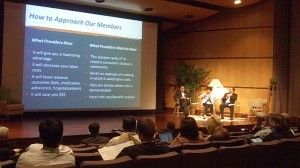Business Plan Competition Showcases Innovative Start-Up Entrepreneurs, Finalists Announced
SANTA CLARA, Calif.–(BUSINESS WIRE)–The eighth annual Silicon Valley Boomer Venture Summit will showcase the latest in mobile and digital advertising trends; new product-distribution channels; and tips and insights to help entrepreneurs, marketers and corporate strategists sharpen their businesses serving the baby-boomer market.
“The ‘longevity marketplace’ for boomers and seniors is akin to the Internet in 1996—without the bubble”
The event is taking place at Santa Clara University’s Leavey School of Business from 7 a.m. to 5:30 p.m. June 15, 2011. The full agenda for the event — the theme of which is “Design for All”— is available at http://www.scuboomerventure.com/agenda.html.
The Summit brings together industry analysts, venture capitalists, entrepreneurs, and business leaders in the field of aging to create a unique forum to explore business ideas, share trends and best-practice information, and design products and services to serve the baby-boomer market in the coming years. Some sessions will cover business financing, including where venture capitalists are investing now in the boomer market segment.
The Summit culminates with two competitions: The Boomer Business Plan and the Elevator Pitch Competition. Finalists will present business ideas for tapping into the boomer marketplace to a panel of judges comprised of leading venture capitalists and experts in the field of aging. Winners will receive a $10,000 grand prize for the best business plan, and $1,000 for best elevator pitch.
This year’s finalists have proposed products and services in a variety of channels within the boomer and senior marketplace, including health and wellness, technology, design and nutrition. A list of business plan competition finalists can be found at http://www.scuboomerventure.com/competitions/finalists.html.
“The ‘longevity marketplace’ for boomers and seniors is akin to the Internet in 1996—without the bubble,” said Mary Furlong, event producer and professor of entrepreneurship at Santa Clara University. “The Summit provides a forum for talented entrepreneurs and the venture capital community to connect around this growing and lucrative marketplace.”
The Summit’s sponsors include AARP, Continuum Crew, First Republic Bank, Southwest Airlines, firstSTREET, UnitedHealthcare, ABHOW, Caring.com, GrandCare Systems, Linkage Ventures, Silverado and SilverRide.
To register online visit www.scuboomerventure.com/register. Costs range from $120 – $195, including special rates for students.
About the Leavey School of Business
The Leavey School of Business at Santa Clara University began in 1923, and was one of the first business schools in the country to receive national accreditation. Its undergraduate business, MBA and Executive MBA programs are consistently ranked among the top in the nation. The curriculum at all levels emphasizes the leadership role of business in creating an ethical society as well as business responsibilities for social justice and sustainability in the global marketplace. The School opened its new $49 million building for undergraduate, graduate, and professional business education in Fall 2008. For more information, see www.scu.edu/business/.
About Mary Furlong & Associates
Mary Furlong & Associates works with companies seeking to capitalize on new business and investment opportunities in the boomer market. The company provides business development, financing strategy and integrated marketing solutions to entrepreneurs, corporations and non-profit organizations serving the 50+ market. Mary Furlong is the Dean’s Executive Professor of Entrepreneurship at Santa Clara University’s Leavey School of Business. For more information: www.maryfurlong.com.
Contacts
 July 26, 2011 at 3:00 p.m. EDT
July 26, 2011 at 3:00 p.m. EDT
 Laura is a founding member of GrandCare Systems, a software technology that combines aspects of Home Automation, Social Networking, Video Chat, Entertainment, Activity of Daily Living monitoring and Tele-health assessment into one flexible and easy-to-use system. A significant part of her role was to bring the product to market through the development of a nation-wide distributor/dealer network while getting the GrandCare brand known throughout the industry. Laura specializes in Social Media and non-traditional guerilla marketing. Laura was a 2011 recipient of the Flame Award for Excellence in Leadership and Innovation from the What’s Next 2011 Boomer Business Innovation Awards.
Laura is a founding member of GrandCare Systems, a software technology that combines aspects of Home Automation, Social Networking, Video Chat, Entertainment, Activity of Daily Living monitoring and Tele-health assessment into one flexible and easy-to-use system. A significant part of her role was to bring the product to market through the development of a nation-wide distributor/dealer network while getting the GrandCare brand known throughout the industry. Laura specializes in Social Media and non-traditional guerilla marketing. Laura was a 2011 recipient of the Flame Award for Excellence in Leadership and Innovation from the What’s Next 2011 Boomer Business Innovation Awards.
 Technology that is properly applied will not only enable, but also strengthen the social bonds between the loved one, their caregiving network and future generations. A successful technology will consider all of the aspects of aging to positively affect physical, emotional, mental and spiritual wellness. If our society does not embrace available technologies to encourage responsible aging, the healthcare costs and the emotional toll taken on familial caregivers will be staggering. Charlie Hillman Founder, GrandCare Systems
Technology that is properly applied will not only enable, but also strengthen the social bonds between the loved one, their caregiving network and future generations. A successful technology will consider all of the aspects of aging to positively affect physical, emotional, mental and spiritual wellness. If our society does not embrace available technologies to encourage responsible aging, the healthcare costs and the emotional toll taken on familial caregivers will be staggering. Charlie Hillman Founder, GrandCare Systems




 Amos Adler, President, Memotext
Amos Adler, President, Memotext


